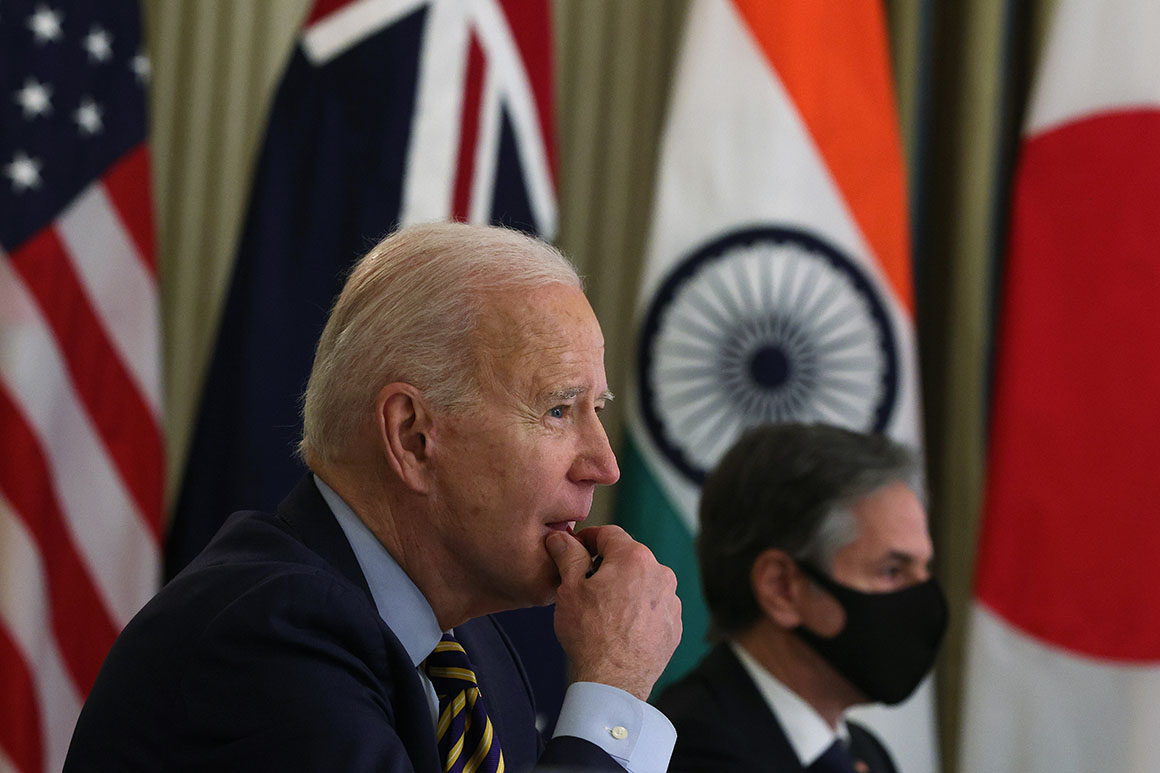
First there was “critical race theory.” Then came the chaotic withdrawal from Afghanistan.
America’s top generals are fighting on terrain they’ve never war-gamed for: congressional hearings where Republicans are calling for their heads and questioning the wisdom of the Pentagon like never before.
Over the past two days, Joint Chiefs Chair Gen. Mark Milley and Secretary of Defense Lloyd Austin were hauled before Senate and House committees to answer for the way they’ve led the military under President Joe Biden and advised him on leaving Afghanistan a month ago, when more than 120,000 people were evacuated and 13 service members killed before the Taliban raised its flag over Kabul on the 20th anniversary of 9/11.
The hostile questioning from Republicans underscored that, while America’s longest war is now over, the fight for the 2022 midterms is just getting started. Afghanistan has become a top issue in conservative media and a rallying cry for Republican candidates eager to make the demoralizing exit a referendum on Biden as his poll numbers fall. And if the Pentagon’s reputation becomes collateral damage in the process, so be it.
“It’s not about Afghanistan. It’s about incompetence,” said Curt Anderson, a GOP strategist who advises senators such as Missouri’s Josh Hawley and Florida’s Rick Scott, the chair of the National Republican Senatorial Committee.
“Democrats and some people in the press are peddling this idea that this will go away,” Anderson said. “But that is a joke, the idea that, ‘oh, this happened. The commander in chief and everyone under him are completely incompetent, and voters will forget about that.’ What? Under what rock are you hiding?”
Democrats, however, point to polling that shows domestic issues are more important to voters, who supported withdrawing from Afghanistan — although they thought it should have been better handled. They also argue that Republicans are being hypocrites in blaming Biden for ending an occupation begun by a Republican president, George W. Bush, and for proceeding with the withdrawal masterminded months before by predecessor Donald Trump.
It was Trump, Democrats also note, who appointed Milley as the chair of the Joint Chiefs of Staff in the first place. Milley earned the left’s ire when he participated in a controversial photo-op with Trump in summer 2020 after protesters were cleared from a park near the White House. When Milley said later that he was unwittingly used as a prop, Trump and the right turned on the general.
But Biden kept Milley on, and the attacks from the right intensified in a June congressional hearing in which he parried a question about critical race theory with a lengthy, viral-ready soliloquy about the military’s need to better understand all theories, and pushed back against GOP criticism that the armed forces had become too “woke.”
The twin issues — the war in Afghanistan and the culture war at home — collided on Wednesday when Rep. Ronny Jackson (R-Texas) attacked Milley for both incidents, as well as for admitting he was a source for at least three recent books that portrayed Trump as an erratic and dangerous leader who mused about improperly using the military to interfere with the 2020 election that he lost.
“Perhaps we would not have had 13 members and hundreds of Afghans killed and service members wounded and citizens abandoned if you had been focused on duty to this country instead of pandering to the Biden administration’s woke social experiment with the U.S. military, doing book interviews and colluding with officials,” Jackson said, calling on Milley to resign.
After an exasperated sigh, Milley responded: “I serve at the pleasure of the president, Mr. Jackson.”
The day before, in a Senate Armed Services Committee hearing, Sen. Hawley (R-Mo.) namechecked the new book “Peril” by Washington Post reporters Bob Woodward and Robert Costa, positing that participating in the effort had “distracted” the general from the deteriorating situation in Afghanistan.
“General, I think you should resign,” Hawley said.
In another fiery exchange, Sen. Marsha Blackburn (R-Tenn.) accused Milley of leaking “private conversations with the president” to Woodward and other authors — a claim Milley rejected, to no avail.
“I think what you did with making time to talk to these authors, burnishing your image, building that bluster, but then not putting the focus on Afghanistan … is disappointing to people that have served with you or under you, under your command, and it does not serve our nation well,” Blackburn said.
Biden has made clear he is standing behind Milley, saying earlier this month that he has “great confidence” in the general after the Woodward revelations first came to light. On Tuesday, White House press secretary Jen Psaki also defended the Pentagon leaders for their approach to the Afghanistan withdrawal.
“They gave their advice, as they should, and then they implemented the president’s decision,” she said.
During the hearings, Democrats defended Biden’s decision to withdraw from Afghanistan and the military’s evacuation effort, which flew 120,000 Afghan allies and American citizens out of Kabul after the Taliban takeover. On Wednesday, Rep. Adam Smith (D-Wash.) applauded the Pentagon for conducting “the largest human airlift in history,” and said that staying in Afghanistan was not worth the price the U.S. would pay in money and lives.
The day before, Sen. Elizabeth Warren (D-Mass.), a fierce critic of the military industrial complex, stressed how the failure in Afghanistan traces back 20 years. She accused Republicans of double-talk, noting that they were “far less interested in this topic” during the Trump administration “as the Afghan government and the Afghan army racked up one failure after another.”
“The Republicans’ sudden interest in Afghanistan is plain old politics,” she said.
With Democrats on defense for Milley and Biden, Rep. Matt Gaetz (R-Fla.) barraged Milley with leading questions and lacerated the general for his previous assessment that the Taliban would not be able to readily defeat the Afghan military.
“You really blew that call, didn’t you, general?” Gaetz said.
He also accused the chair of having spent more time in conversations with Woodward than “analyzing the very likely prospect that the Afghanistan government was going to fall immediately to the Taliban.” Gaetz emphasized his point by brandishing a copy of the book.
“If we didn’t have a president that was so addled, you all would be fired,” Gaetz told the panel, “because that is what you deserve.”
Milley vigorously defended himself during both hearings, preempting lawmakers’ questions about the Woodward book by directly addressing them in his opening statement. He said that his two phone calls with Gen. Li Zuocheng during the final tumultuous months of the Trump administration were intended to reassure the Chinese that the U.S. would not launch an attack.
The first call, in October, was made at the behest of then-Defense Secretary Mark Esper; the second, just days before the Jan. 6 attack on the U.S. Capitol, was done at the request of the Chinese and coordinated with then-acting Defense Secretary Christopher Miller, Milley said.
The general stressed that the calls were part of his regular duties to “deconflict military actions, manage crisis and prevent war between great powers armed with nuclear weapons.”
He also fired back at lawmakers asking why he had not resigned in protest after Biden dismissed his advice to leave troops in Afghanistan, arguing that such a move would have been “an incredible act of political defiance.”
“This country doesn’t want generals figuring out what orders we are going to accept and do or not. That’s not our job,” he said.
Gaetz and Milley first clashed in June when the Florida Republican brought up critical race theory and tried to draw Austin, who is Black, into the discussion. Austin demurred. But Milley didn’t and incensed the right in June during an impassioned exchange with the lawmakers.
“I personally find it offensive that we are accusing the United States military … of being ‘woke’ or something else because we’re studying some theories that are out there,” Milley said.
“I’ve read Mao Tse Tung. I’ve read Karl Marx. I’ve read Lenin. That doesn’t make me a communist,” Milley continued. “So what is wrong with understanding, having some situational understanding about the country for which we are here to defend?”
Gaetz later called Milley “the chairman of the woketopia,” and Fox News anchor Tucker Carlson said the general is “not just a pig, he’s stupid.” Former President Trump himself called on Milley to resign over the remarks in June, calling them “sad” and “pathetic.”
The brutal back-and-forth has surprised even veteran Pentagon officials, who are accustomed to Republicans being more deferential to the military — although less so during Democratic administrations — and who worry that the military could become just another institution that’s dragged into partisan warfare.
“My concern is that the military will be seen politically and that the trust in the military will be affected by it,” said David Lapan, a former spokesperson for the Pentagon and, most recently, the Department of Homeland Security under Trump. “The military has been one of the most-trusted institutions in the United States, but the worry is people will start to doubt the military’s allegiance to the country.”
Mary Kaszynski, a spokesperson for the Democratic-aligned VoteVets group, said American voters “are sophisticated,” were able to see that Trump tried to misuse the military for his own ends and that Republicans are being “hypocrites” for their vociferous criticisms of the withdrawal.
“Foreign policy is never voters’ No. 1 issue. And it’s very unlikely to be the No. 1 issue a year from now,” she said, pointing to polling done by the group last month. “We’re in the midst of an unprecedented pandemic. There’s the economy. People are worried about jobs, health care and climate. Even among veterans, a community that skews right, there’s strong two-to-one support to end the war.”
While Democrats believe Afghanistan will fade, Republicans have signaled they’ll keep the pressure on in Congress, the campaign trail and in media. The ongoing resettlement of tens of thousands of Afghan evacuees also promises to keep the issue alive in the coming months.
Republican strategist Chris LaCivita, a Marine Corps veteran, acknowledged that Afghanistan by itself won’t be a central issue of the midterms, but Republicans say it will be part of a broader narrative they want to tell about Democrats’ foreign policy, not unlike the aftermath of the 2012 terrorist attacks on the U.S. consulate in Benghazi, Libya.
“Afghanistan is not Dunkirk. It’s more of a Benghazi multiplied by 10,” he said.











